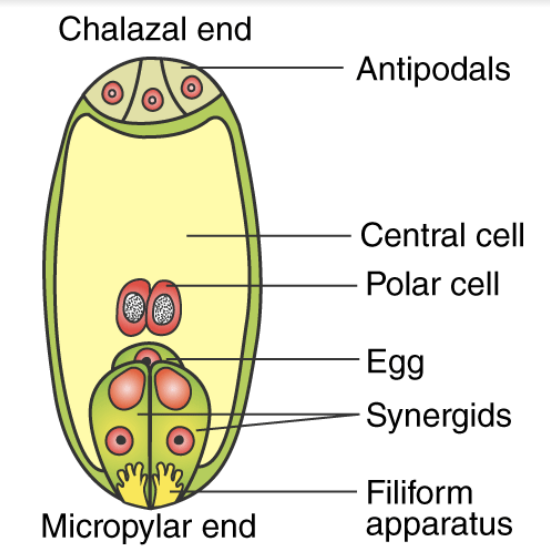
Define the term double fertilization in plants. After fertilization name the part in case which develops into (i) the fruit (ii) the seed.
Answer
410.1k+ views
Hint: This process specifically occurs in angiosperms only. We are well known for the mature, developed structure of a female gametophyte. It contains 2 synergids + 1 egg in the micropylar end and 3 antipodal cells in the chalazal end. Two polar nuclei from each pole (end) come together in the middle and combine together to form the polar nuclei. All the cells are haploid (n), except the polar nuclei, which is diploid (2n). The two polar nuclei fuse just before fertilization.
Complete answer:
Now after pollination, the pollen tube containing the two male gametes creeps into one of the synergids, and the male gametes enter into the cytoplasm of the synergids. The two events which take place in this course are:
1. Syngamy:
Male gamete (n) + Egg (n) → Zygote (2n)
The male gamete moves towards the egg cell and fuses with it eventually. This results in the formation of zygote.
2. Triple Fusion:
Male gamete (n) + Two fused polar nuclei (2n) → Primary Endosperm nucleus (PEN)
The other male gamete moves towards the two polar nuclei located in the central cell and fuses with them to produce a triploid PEN.
Since the fusion occurs two times, i.e., syngamy and triple fusion, that is why this whole phenomenon is termed as double fertilization.
Now, after fertilization, a series of events which are known as post-fertilization events starts. These are:
1. Endosperm development
2. Embryo development
3. Ovules maturing into seed
4. Ovary maturing into fruit

Note:
Some certain important and useful points to be noted are:
Growth of the pollen tube is totally chemotropic. The synergids attract the pollen tube towards them through a series of chemical interactions.
Pollan tube was first observed by G.B. Amici (1824) in Portulaca.
Strasburger discovered syngamy in Monotropa.
Triple fusion and double fertilization were discovered by S.G. Nawaschin and Guignard in Lilium and Fritillaria.
The phenomenon of double fertilization in 80% of the angiosperm families makes the endosperm triploid (3n). But in certain plants like Oenothera, the endosperm is diploid. But that does not necessarily mean that the vent of triple fusion does not occur in Oenothera. This difference is due to differences in the development of the female gametophyte stage.
Complete answer:
Now after pollination, the pollen tube containing the two male gametes creeps into one of the synergids, and the male gametes enter into the cytoplasm of the synergids. The two events which take place in this course are:
1. Syngamy:
Male gamete (n) + Egg (n) → Zygote (2n)
The male gamete moves towards the egg cell and fuses with it eventually. This results in the formation of zygote.
2. Triple Fusion:
Male gamete (n) + Two fused polar nuclei (2n) → Primary Endosperm nucleus (PEN)
The other male gamete moves towards the two polar nuclei located in the central cell and fuses with them to produce a triploid PEN.
Since the fusion occurs two times, i.e., syngamy and triple fusion, that is why this whole phenomenon is termed as double fertilization.
Now, after fertilization, a series of events which are known as post-fertilization events starts. These are:
1. Endosperm development
2. Embryo development
3. Ovules maturing into seed
4. Ovary maturing into fruit

Note:
Some certain important and useful points to be noted are:
Growth of the pollen tube is totally chemotropic. The synergids attract the pollen tube towards them through a series of chemical interactions.
Pollan tube was first observed by G.B. Amici (1824) in Portulaca.
Strasburger discovered syngamy in Monotropa.
Triple fusion and double fertilization were discovered by S.G. Nawaschin and Guignard in Lilium and Fritillaria.
The phenomenon of double fertilization in 80% of the angiosperm families makes the endosperm triploid (3n). But in certain plants like Oenothera, the endosperm is diploid. But that does not necessarily mean that the vent of triple fusion does not occur in Oenothera. This difference is due to differences in the development of the female gametophyte stage.
Recently Updated Pages
Master Class 12 Business Studies: Engaging Questions & Answers for Success

Master Class 12 English: Engaging Questions & Answers for Success

Master Class 12 Social Science: Engaging Questions & Answers for Success

Master Class 12 Chemistry: Engaging Questions & Answers for Success

Class 12 Question and Answer - Your Ultimate Solutions Guide

Master Class 11 Physics: Engaging Questions & Answers for Success

Trending doubts
Draw a labelled sketch of the human eye class 12 physics CBSE

a Tabulate the differences in the characteristics of class 12 chemistry CBSE

Which one of the following is a true fish A Jellyfish class 12 biology CBSE

Why is the cell called the structural and functional class 12 biology CBSE

Differentiate between homogeneous and heterogeneous class 12 chemistry CBSE

Write the difference between solid liquid and gas class 12 chemistry CBSE




